Estimation of Maize Yield in Plastic Film Mulched Field Using UAV Multispectral Imagery
Abstract
1. Introduction
2. Materials and Methods
2.1. Study Area
2.2. Experimental Design
2.3. Ground Sampling
2.4. Using UAV to Acquire Remote Sensing Data
2.5. Data Processing
3. Results
3.1. Growing Season Climatic Patterns
3.2. Growth Period Changes of LAI
3.3. Growth Period Changes of LB
3.4. Time Series Variation of Vegetation Indices (VIs) Obtained by UAV
3.5. Vegetation Indices as Indicators of Crop Growth Performance
3.6. Correlation Analysis of Vegetation Indices (VIs) and Yield
4. Discussion
4.1. Vegetation Indices (VIs)
4.2. Remote Sensing-Guided Phenotyping
4.3. Limitations and Future Studies
5. Conclusion
Supplementary Materials
Author Contributions
Funding
Data Availability Statement
Acknowledgments
Conflicts of Interest
References
- Zhang, F.; Zhang, W.; Qi, J.; Li, F.-M. A regional evaluation of plastic film mulching for improving crop yields on the Loess Plateau of China. Agric. For. Meteorol. 2018, 248, 458–468. [Google Scholar] [CrossRef]
- Zhang, K.; Li, Z.; Li, Y.; Wan, P.; Chai, N.; Li, M.; Wei, H.; Kuzyakov, Y.; Filimonenko, E.; Alharbi, S.A.; et al. Contrasting impacts of plastic film mulching and nitrogen fertilization on soil organic matter turnover. Geoderma 2023, 440, 116714. [Google Scholar] [CrossRef]
- Piao, S.L.; Ciais, P.; Huang, Y.; Shen, Z.H.; Peng, S.S.; Li, J.S.; Zhou, L.P.; Liu, H.Y.; Ma, Y.C.; Ding, Y.H.; et al. The impacts of climate change on water resources and agriculture in China. Nature 2010, 467, 43–51. [Google Scholar] [CrossRef]
- Schirrmann, M.; Giebel, A.; Gleiniger, F.; Pflanz, M.; Lentschke, J.; Dammer, K.-H. Monitoring Agronomic Parameters of Winter Wheat Crops with Low-Cost UAV Imagery. Remote. Sens. 2016, 8, 706. [Google Scholar] [CrossRef]
- Raza, A.; Shahid, M.A.; Zaman, M.; Miao, Y.; Huang, Y.; Safdar, M.; Maqbool, S.; Muhammad, N.E. Improving Wheat Yield Prediction with Multi-Source Remote Sensing Data and Machine Learning in Arid Regions. Remote. Sens. 2025, 17, 774. [Google Scholar] [CrossRef]
- Baret, F.; Guyot, G. Potentials and Limits of Vegetation Indexes for Lai and Apar Assessment. Remote. Sens. Environ. 1991, 35, 161–173. [Google Scholar] [CrossRef]
- Basso, B.; Liu, L. Seasonal crop yield forecast: Methods, applications, and accuracies. Adv. Agron. 2018, 154, 201–255. [Google Scholar]
- Ansarifar, J.; Wang, L.; Archontoulis, S.V. An interaction regression model for crop yield prediction. Sci. Rep. 2021, 11, 17754. [Google Scholar] [CrossRef] [PubMed]
- Wulder, M.A.; Loveland, T.R.; Roy, D.P.; Crawford, C.J.; Masek, J.G.; Woodcock, C.E.; Allen, R.G.; Anderson, M.C.; Belward, A.S.; Cohen, W.B.; et al. Current status of Landsat program, science, and applications. Remote Sens. Environ. 2019, 225, 127–147. [Google Scholar] [CrossRef]
- Jin, Z.; Prasad, R.; Shriver, J.; Zhuang, Q. Crop model- and satellite imagery-based recommendation tool for variable rate N fertilizer application for the US Corn system. Precis. Agric. 2017, 18, 779–800. [Google Scholar] [CrossRef]
- Cheng, E.; Zhang, B.; Peng, D.; Zhong, L.; Yu, L.; Liu, Y.; Xiao, C.; Li, C.; Li, X.; Chen, Y.; et al. Wheat yield estimation using remote sensing data based on machine learning approaches. Front. Plant Sci. 2022, 13, 1090970. [Google Scholar] [CrossRef]
- Yao, X.; Wang, N.; Liu, Y.; Cheng, T.; Tian, Y.; Chen, Q.; Zhu, Y. Estimation of Wheat LAI at Middle to High Levels Using Unmanned Aerial Vehicle Narrowband Multispectral Imagery. Remote. Sens. 2017, 9, 1304. [Google Scholar] [CrossRef]
- Wan, L.; Cen, H.; Zhu, J.; Zhang, J.; Zhu, Y.; Sun, D.; Du, X.; Zhai, L.; Weng, H.; Li, Y.; et al. Grain yield prediction of rice using multi-temporal UAV-based RGB and multispectral images and model transfer—A case study of small farmlands in the South of China. Agric. For. Meteorol. 2020, 291, 108096. [Google Scholar] [CrossRef]
- Cheng, Z.; Gu, X.; Du, Y.; Zhou, Z.; Li, W.; Zheng, X.; Cai, W.; Chang, T. Spectral purification improves monitoring accuracy of the comprehensive growth evaluation index for film-mulched winter wheat. J. Integr. Agric. 2023, 23, 1523–1540. [Google Scholar] [CrossRef]
- Snyder, K.; Grant, A.; Murray, C.; Wolff, B. The Effects of Plastic Mulch Systems on Soil Temperature and Moisture in Central Ontario. HortTechnology 2015, 25, 162–170. [Google Scholar] [CrossRef]
- Al-Shammari, D.; Bishop, T.F.; Wang, C.; Whelan, B.M.; Bramley, R.G. A comparison between machine learning and simple mechanistic-type models for yield prediction in site-specific crop yield predictions. In Proceedings of the 20th Agronomy Australia Conference, Toowoomba, QLD, Australia, 18–22 September 2022. [Google Scholar]
- Tsouros, D.C.; Bibi, S.; Sarigiannidis, P.G. A Review on UAV-Based Applications for Precision Agriculture. Information 2019, 10, 349. [Google Scholar] [CrossRef]
- Sun, X.-L. Errors induced by spectral measurement positions and instrument noise in soil organic carbon prediction using vis-NIR on intact soil. Geoderma 2021, 382, 114731. [Google Scholar] [CrossRef]
- Zhang, F.; Zhang, W.; Li, M.; Yang, Y.; Li, F.M. Does long-term plastic film mulching really decrease sequestration of organic carbon in soil in the Loess Plateau? Eur. J. Agron. 2017, 89, 53–60. [Google Scholar] [CrossRef]
- Islam, M.R.; Garcia, S.C.; Henry, D. Use of normalised difference vegetation index, nitrogen concentration, and total nitrogen content of whole maize plant and plant fractions to estimate yield and nutritive value of hybrid forage maize. Crop. Pasture Sci. 2011, 62, 374–382. [Google Scholar] [CrossRef]
- Ben-Ze’Ev, E.; Karnieli, A.; Agam, N.; Kaufman, Y.; Holben, B. Assessing vegetation condition in the presence of biomass burning smoke by applying the Aerosol-free Vegetation Index (AFRI) on MODIS images. Int. J. Remote. Sens. 2006, 27, 3203–3221. [Google Scholar] [CrossRef]
- Huete, A.R. A Soil-Adjusted Vegetation Index (Savi). Remote Sens. Environ. 1988, 25, 295–309. [Google Scholar] [CrossRef]
- Jiang, Z.; Huete, A.R.; Didan, K.; Miura, T. Development of a two-band enhanced vegetation index without a blue band. Remote Sens. Environ. 2008, 112, 3833–3845. [Google Scholar] [CrossRef]
- Kong, M.; Jia, Y.; Gu, Y.-J.; Han, C.-L.; Song, X.; Shi, X.-Y.; Siddique, K.H.; Zdruli, P.; Zhang, F.; Li, F.-M. How Film Mulch Increases the Corn Yield by Improving the Soil Moisture and Temperature in the Early Growing Period in a Cool, Semi-Arid Area. Agronomy 2020, 10, 1195. [Google Scholar] [CrossRef]
- Gitelson, A.A.; Viña, A.; Ciganda, V.; Rundquist, D.C.; Arkebauer, T.J. Remote estimation of canopy chlorophyll in crops. Geophys. Res. Lett. 2005, 32, L08403. [Google Scholar] [CrossRef]
- Shanahan, J.F.; Holland, K.H.; Schepers, J.S.; Francis, D.D.; Schlemmer, M.R.; Caldwell, R.; VanToai, T.; Major, D.; McDonald, M.; Tarpley, L. Use of a Crop Canopy Reflectance Sensor to Assess Corn Leaf Chlorophyll Content. Digit. Imaging Spectr. Tech. Appl. Precis. Agric. Crop Physiol. 2003, 66, 135–150. [Google Scholar]
- Da Silva, E.E.; Baio, F.H.R.; Teodoro, L.P.R.; da Silva Junior, C.A.; Borges, R.S.; Teodoro, P.E. UAV-multispectral and vegetation indices in soybean grain yield prediction based on in situ observation. Remote Sens. Appl. Soc. Environ. 2020, 18, 100318. [Google Scholar] [CrossRef]
- Maimaitijiang, M.; Sagan, V.; Sidike, P.; Hartling, S.; Esposito, F.; Fritschi, F.B. Soybean yield prediction from UAV using multimodal data fusion and deep learning. Remote. Sens. Environ. 2020, 237, 111599. [Google Scholar] [CrossRef]
- Song, X.; Xu, D.; Huang, C.; Zhang, K.; Huang, S.; Guo, D.; Zhang, S.; Yue, K.; Guo, T.; Wang, S.; et al. Monitoring of nitrogen accumulation in wheat plants based on hyperspectral data. Remote. Sens. Appl. Soc. Environ. 2021, 23, 100598. [Google Scholar] [CrossRef]
- Molette, C.; Berzaghi, P.; Zotte, A.D.; Remignon, H.; Babile, R. The Use of Near-Infrared Reflectance Spectroscopy in the Prediction of the Chemical Composition of Goose Fatty Liver. Poult. Sci. 2001, 80, 1625–1629. [Google Scholar] [CrossRef]
- Joshi, A.; Pradhan, B.; Gite, S.; Chakraborty, S. Remote-Sensing Data and Deep-Learning Techniques in Crop Mapping and Yield Prediction: A Systematic Review. Remote. Sens. 2023, 15, 2014. [Google Scholar] [CrossRef]
- Zhang, F.; Zhang, W.; Li, M.; Zhang, Y.; Li, F.; Li, C. Is crop biomass and soil carbon storage sustainable with long-term application of full plastic film mulching under future climate change? Agric. Syst. 2017, 150, 67–77. [Google Scholar] [CrossRef]
- Zhang, F.; Eldoma, I.M.; Li, M.; Kong, M.; Siddique, K.H.; Li, F.-M. Integrated model and field experiment to determine the optimum planting density in plastic film mulched rainfed agriculture. Agric. For. Meteorol. 2019, 268, 331–340. [Google Scholar] [CrossRef]
- Carlson, T.N.; Ripley, D.A. On the relation between NDVI, fractional vegetation cover, and leaf area index. Remote Sens. Environ. 1997, 62, 241–252. [Google Scholar] [CrossRef]
- Li, G.; Zhang, H.; Wu, X.; Shi, C.; Huang, X.; Qin, P. Canopy reflectance in two castor bean varieties (Ricinus communis L.) for growth assessment and yield prediction on coastal saline land of Yancheng District, China. Ind. Crop. Prod. 2011, 33, 395–402. [Google Scholar] [CrossRef]
- Priebe, S.; Huxley, P.; Knight, S.; Evans, S. Application and results of the Manchester Short Assessment of Quality of Life (MANSA). Int. J. Soc. Psychiatry 1999, 45, 7–12. [Google Scholar] [CrossRef]
- Chen, L.; Huang, J.F.; Wang, X.Z. Estimation accuracy and sensitivity of rice leaf area index by simulated vegetation index of different sensors. J. Remote Sens. 2008, 12, 143–151. [Google Scholar]
- Woebbecke, D.M.; Meyer, G.E.; Von Bargen, K.; Mortensen, D.A. Color Indexes for Weed Identification under Various Soil, Residue, and Lighting Conditions. Trans. Asae 1995, 38, 259–269. [Google Scholar] [CrossRef]
- Qi, J.; Chehbouni, A.; Huete, A.R.; Kerr, Y.H.; Sorooshian, S. A Modified Soil Adjusted Vegetation Index. Remote Sens. Environ. 1994, 48, 119–126. [Google Scholar] [CrossRef]
- Bolton, D.K.; Friedl, M.A. Forecasting crop yield using remotely sensed vegetation indices and crop phenology metrics. Agric. For. Meteorol. 2013, 173, 74–84. [Google Scholar] [CrossRef]
- Demetriadesshah, T.H.; Steven, M.D.; Clark, J.A. High-Resolution Derivative Spectra in Remote-Sensing. Remote Sens. Environ. 1990, 33, 55–64. [Google Scholar] [CrossRef]
- Wu, W.C. The Generalized Difference Vegetation Index (GDVI) for Dryland Characterization. Remote Sens. 2014, 6, 1211–1233. [Google Scholar] [CrossRef]
- Karcher, D.E.; Richardson, M.D. Quantifying turfgrass color using digital image analysis. Crop Sci. 2003, 43, 943–951. [Google Scholar] [CrossRef]
- Chen, P.F.; Wang, J.L.; Liao, X.Y.; Yin, F.; Chen, B.R.; Liu, R. Research on aboveground biomass inversion of Hulunbuir grassland based on environmental disaster reduction satellite remote sensing data. J. Nat. Resour. 2010, 25, 1122–1131. [Google Scholar]
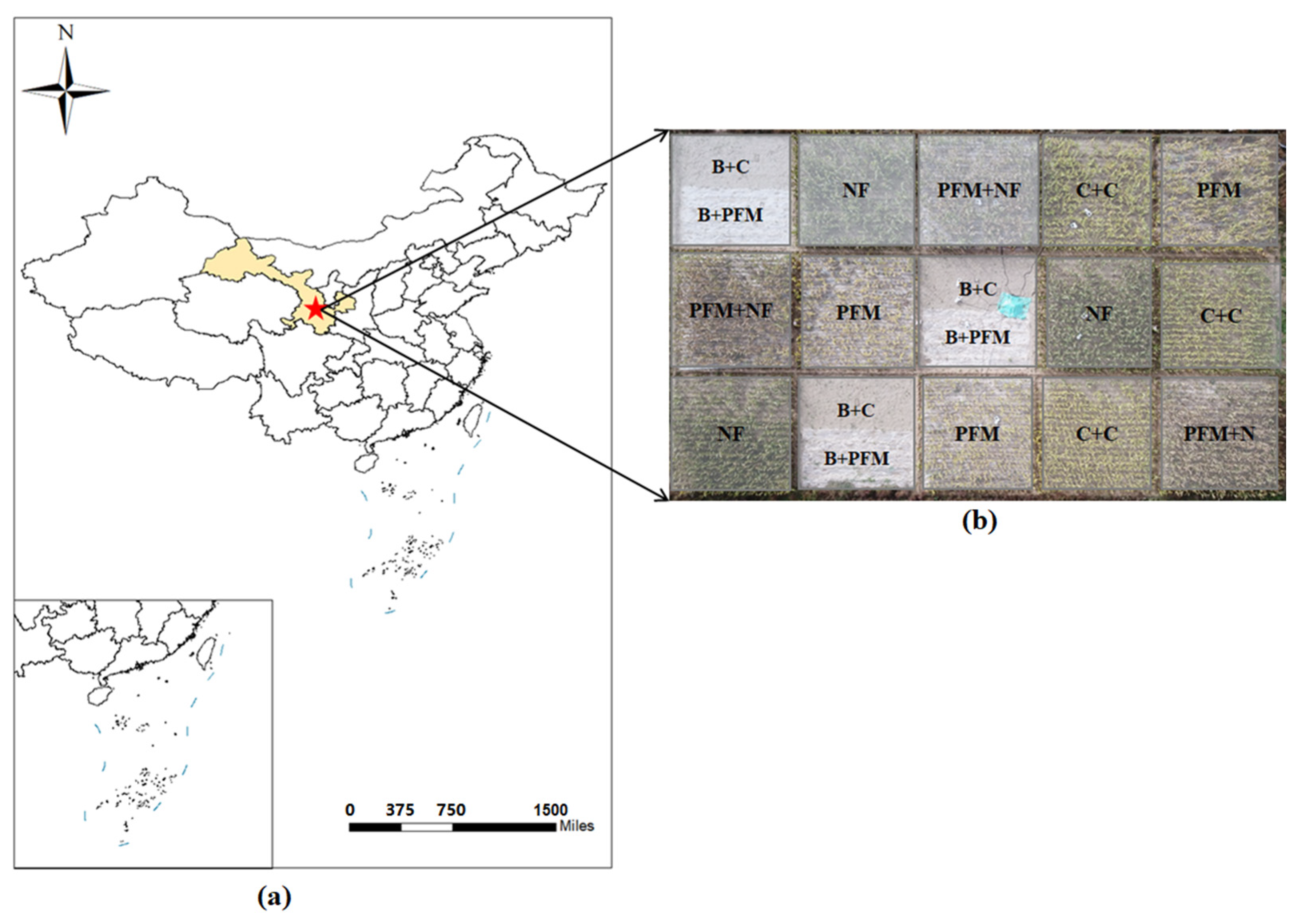

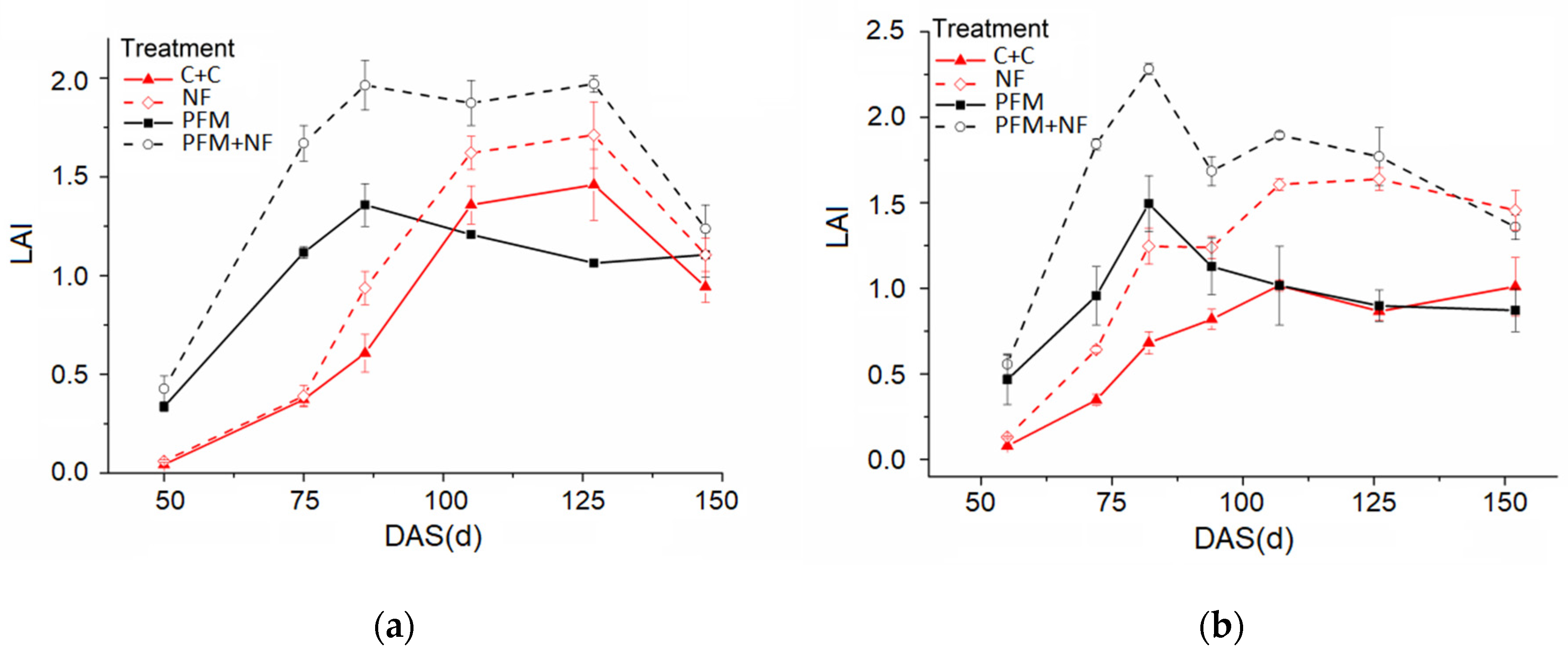
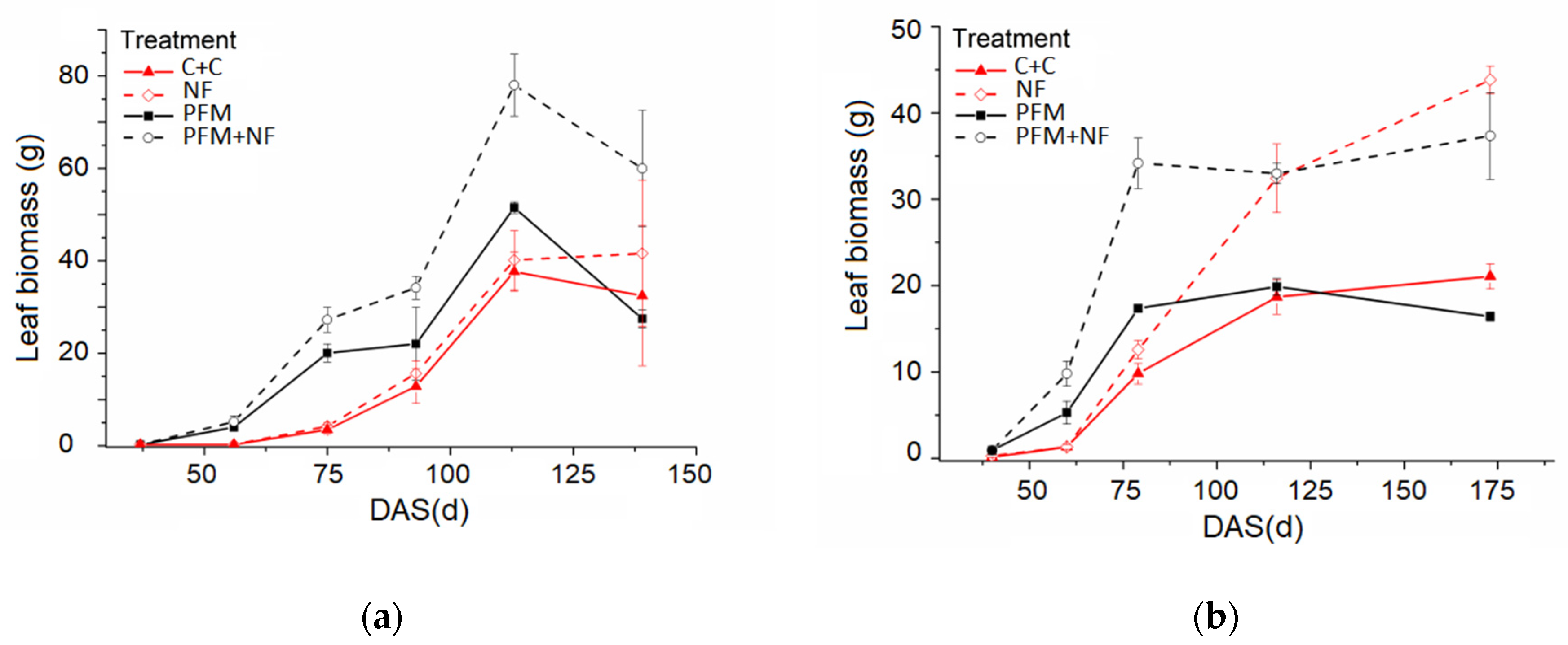
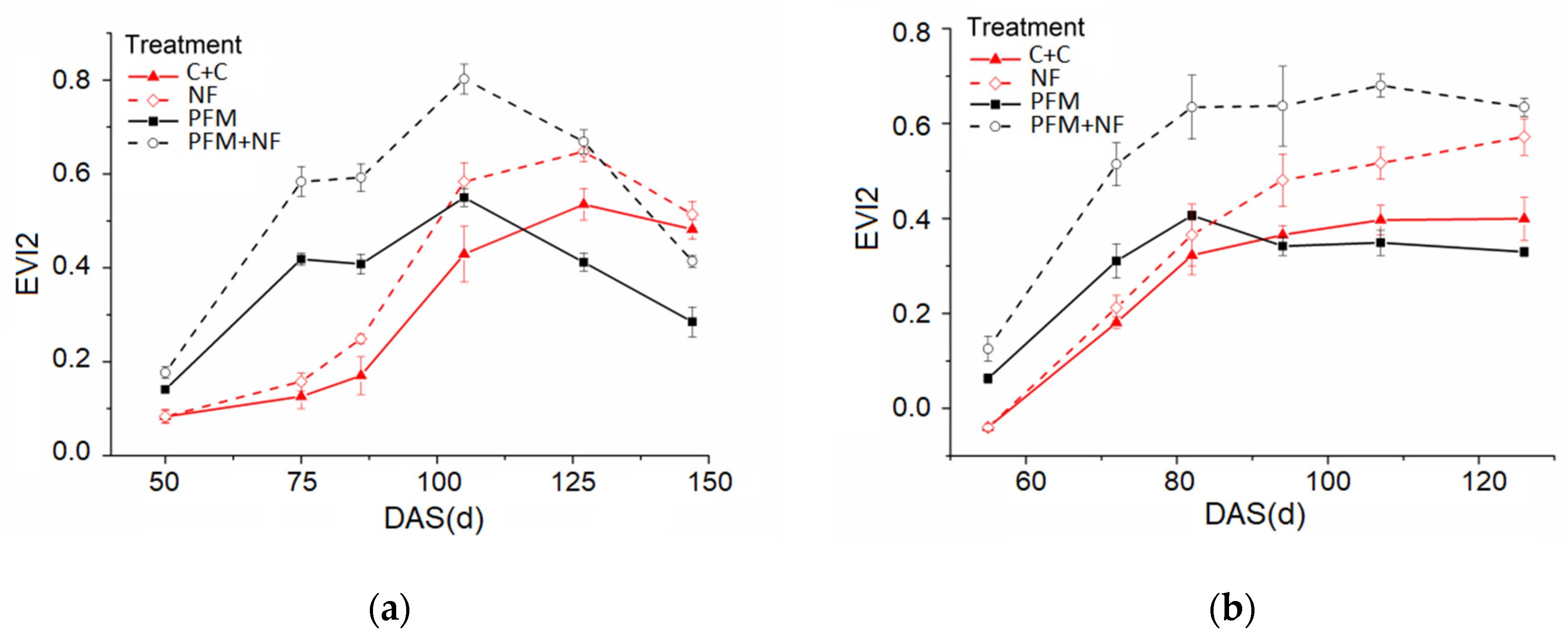

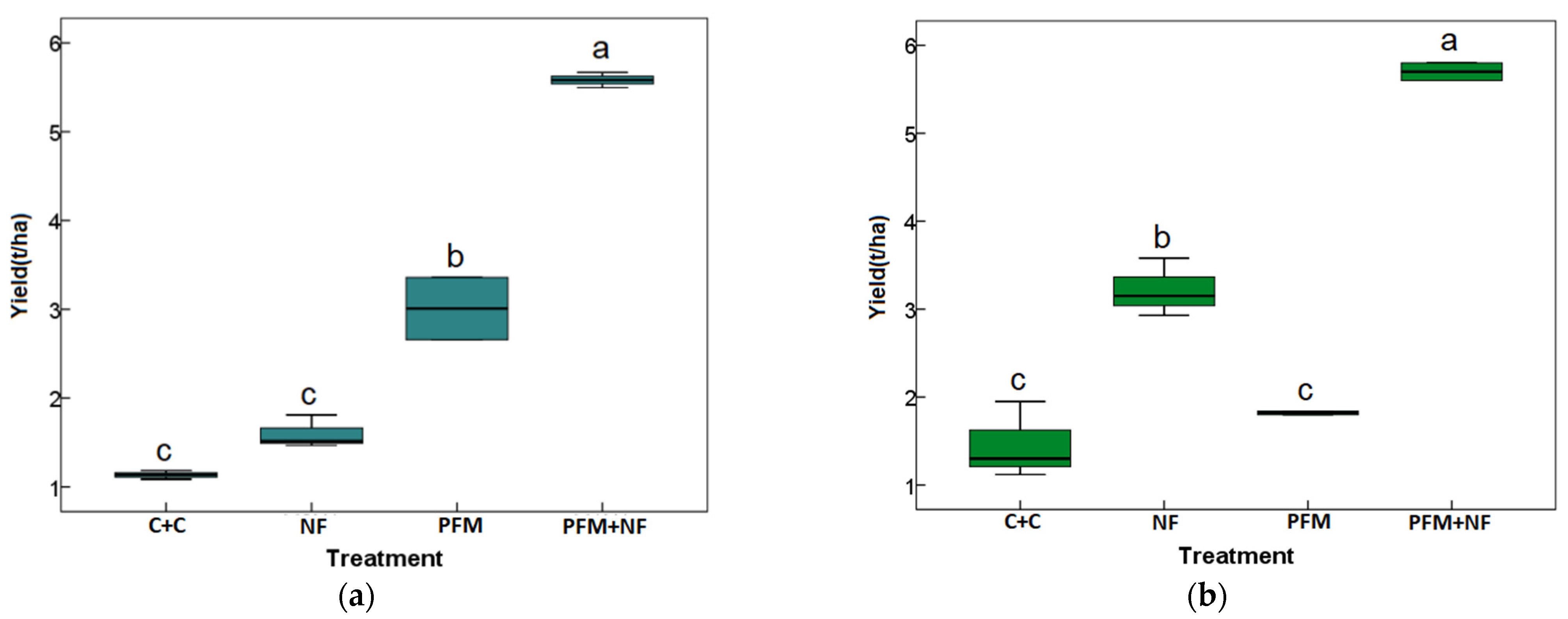
| VIs | 2019 | 2020 | ||||
|---|---|---|---|---|---|---|
| Equation | R2 | RMSE | Equation | R2 | RMSE | |
| NDVI | y = −2.42 + 6.16x | 0.79 | 0.27 | y = 0.09 + 5.19x | 0.69 | 0.35 |
| GNDVI | y = 0.20 + 5.53x | 0.73 | 0.31 | y = −1.53 + 5.98x | 0.70 | 0.34 |
| EXG | y = −0.28 + 11.17x | 0.53 | 0.41 | y = −0.48 + 2.82x | 0.18 | 0.56 |
| SAVI | y = 0.09 + 3.46x | 0.79 | 0.27 | y = −1.87 + 3.64x | 0.66 | 0.36 |
| MSAVI | y = 0.17 + 3.74x | 0.72 | 0.31 | y = −2.48 + 5.56x | 0.78 | 0.29 |
| RVI | y = −1 + 0.52x | 0.62 | 0.36 | y = −1.02 + 0.38x | 0.53 | 0.43 |
| GRVI | y = −0.24 + 1.09x | 0.71 | 0.32 | y = −0.55 + 0.54x | 0.52 | 0.43 |
| EVI | y = 0.28 + 1.29x | 0.69 | 0.33 | y = 0.18 + 1.44x | 0.66 | 0.36 |
| EVI2 | y = 0.048 + 2.65x | 0.85 | 0.25 | y = 0.089 + 2.63x | 0.84 | 0.23 |
| DVI | y = −0.72 + 7.72x | 0.68 | 0.33 | y = −2.53 + 10.04x | 0.73 | 0.32 |
| GDVI | y = −8.53 + 13.69x | 0.74 | 0.31 | y = −3.51 + 12.83 | 0.57 | 0.41 |
| MTVI2 | y = 0.17 + 2.6x | 0.71 | 0.32 | y = 0.1 + 2.92x | 0.74 | 0.31 |
| DGCI | y = −0.25 + 15.09x | 0.73 | 0.31 | y = −0.15 + 14.18x | 0.58 | 0.41 |
| y | x | Expression | R2 | RMSE (g) | p-Value |
|---|---|---|---|---|---|
| LB | EVI2 | y = −7.43 + 89.6x | 0.82 | 8.84 | *** |
| AGB | EVI2 | y = −22.67 + 260.93x | 0.66 | 39.58 | *** |
| TB | EVI2 | y = −26.17 + 294.23x | 0.66 | 45.44 | *** |
| LB | NDVI | y = −8.74 +189.41x | 0.70 | 12.02 | *** |
| AGB | NDVI | y = −25.28 + 557.7x | 0.49 | 54.27 | *** |
| TB | NDVI | y = −29.56 + 628.32x | 0.50 | 60.92 | *** |
| LB | GNDVI | y = −12.38 + 246.91x | 0.72 | 11.03 | *** |
| AGB | GNDVI | y = −40.44 + 758.39x | 0.50 | 52.90 | *** |
| TB | GNDVI | y = −44.25 + 840.80x | 0.51 | 60.66 | *** |
| LB | GRVI | y = −42.67 + 22.26x | 0.78 | 10.01 | *** |
| AGB | GRVI | y = −131.60 + 67.62x | 0.60 | 48.42 | *** |
| TB | GRVI | y = −145.12 + 75x | 0.60 | 54.77 | *** |
| LB | SAVI | y = −9.10 + 128.02x | 0.70 | 11.92 | *** |
| AGB | SAVI | y = −26.42 + 377.39x | 0.50 | 53.99 | *** |
| TB | SAVI | y = −30.82 + 425.03x | 0.51 | 60.51 | *** |
| LB | MSAVI | y = −11.93 + 158.74x | 0.61 | 13.61 | *** |
| AGB | MSAVI | y = −36.46 + 474.86x | 0.44 | 56.69 | *** |
| TB | MSAVI | y = −42.05 + 529.92x | 0.45 | 63.91 | *** |
| LB | MTVI2 | y = −1.37 + 88.98x | 0.56 | 14.34 | *** |
| AGB | MTVI2 | y = −3.77 + 262.58x | 0.40 | 58.86 | *** |
| TB | MTVI2 | y = −6.37 + 295.25x | 0.41 | 66.19 | *** |
| Year | 2019 | 2019 | 2019 | 2019 | 2019 | 2019 | 2020 | 2020 | 2020 | 2020 | 2020 | 2020 | |
|---|---|---|---|---|---|---|---|---|---|---|---|---|---|
| Date | 6/17 | 7/12 | 7/23 | 8/11 | 9/2 | 9/22 | 6/18 | 7/5 | 7/15 | 7/27 | 8/9 | 8/28 | |
| VIs | |||||||||||||
| EVI2 | 0.83 | 0.92 | 0.91 | 0.68 | 0.002 | 0.06 | 0.43 | 0.67 | 0.69 | 0.78 | 0.94 | 0.71 | |
| EVI | 0.51 | 0.30 | 0.59 | 0.28 | 0.41 | 0.02 | 0.05 | 0.32 | 0.53 | 0.47 | 0.41 | 0.59 | |
| NDVI | 0.79 | 0.86 | 0.79 | 0.57 | 0.29 | 0.11 | 0.41 | 0.66 | 0.67 | 0.82 | 0.92 | 0.70 | |
| GNDVI | 0.53 | 0.93 | 0.86 | 0.62 | 0.05 | 0.08 | 0.56 | 0.83 | 0.71 | 0.74 | 0.76 | 0.66 | |
| SAVI | 0.78 | 0.87 | 0.87 | 0.59 | 0.21 | 0.09 | 0.41 | 0.66 | 0.67 | 0.82 | 0.92 | 0.70 | |
| MSAVI | 0.76 | 0.88 | 0.95 | 0.63 | 0.08 | 0.09 | 0.37 | 0.52 | 0.62 | 0.78 | 0.88 | 0.68 | |
| MTVI2 | 0.79 | 0.82 | 0.68 | 0.44 | 0.11 | 0.25 | 0.28 | 0.45 | 0.45 | 0.48 | 0.85 | 0.69 | |
| RVI | 0.68 | 0.85 | 0.34 | 0.49 | 0.17 | 0.10 | 0.51 | 0.71 | 0.22 | 0.11 | 0.71 | 0.54 | |
| GRVI | 0.03 | 0.90 | 0.41 | 0.64 | 0.06 | 0.07 | 0.54 | 0.81 | 0.83 | 0.75 | 0.75 | 0.69 | |
| DVI | 0.79 | 0.88 | 0.79 | 0.54 | 0.37 | 0.07 | 0.36 | 0.57 | 0.55 | 0.83 | 0.74 | 0.60 | |
| GDVI | 0.09 | 0.93 | 0.91 | 0.59 | 0.41 | 0.08 | 0.26 | 0.27 | 0.15 | 0.06 | 0.48 | 0.04 | |
| EGI | 0.75 | 0.11 | 0.07 | 0.02 | 0.21 | 0.04 | 0.41 | 0.55 | 0.62 | 0.66 | 0.74 | 0.62 | |
| DGCI | 0.80 | 0.76 | 0.91 | 0.66 | 0.48 | 0.01 | 0.25 | 0.71 | 0.81 | 0.95 | 0.87 | 0.86 | |
Disclaimer/Publisher’s Note: The statements, opinions and data contained in all publications are solely those of the individual author(s) and contributor(s) and not of MDPI and/or the editor(s). MDPI and/or the editor(s) disclaim responsibility for any injury to people or property resulting from any ideas, methods, instructions or products referred to in the content. |
© 2025 by the authors. Licensee MDPI, Basel, Switzerland. This article is an open access article distributed under the terms and conditions of the Creative Commons Attribution (CC BY) license (https://creativecommons.org/licenses/by/4.0/).
Share and Cite
Wang, Y.; Hou, M.; Zhao, Z.; Zhang, K.; Huang, J.; Zhang, L.; Zhang, F. Estimation of Maize Yield in Plastic Film Mulched Field Using UAV Multispectral Imagery. Agronomy 2025, 15, 1269. https://doi.org/10.3390/agronomy15061269
Wang Y, Hou M, Zhao Z, Zhang K, Huang J, Zhang L, Zhang F. Estimation of Maize Yield in Plastic Film Mulched Field Using UAV Multispectral Imagery. Agronomy. 2025; 15(6):1269. https://doi.org/10.3390/agronomy15061269
Chicago/Turabian StyleWang, Yue, Min Hou, Zeyu Zhao, Kaiping Zhang, Jie Huang, Li Zhang, and Feng Zhang. 2025. "Estimation of Maize Yield in Plastic Film Mulched Field Using UAV Multispectral Imagery" Agronomy 15, no. 6: 1269. https://doi.org/10.3390/agronomy15061269
APA StyleWang, Y., Hou, M., Zhao, Z., Zhang, K., Huang, J., Zhang, L., & Zhang, F. (2025). Estimation of Maize Yield in Plastic Film Mulched Field Using UAV Multispectral Imagery. Agronomy, 15(6), 1269. https://doi.org/10.3390/agronomy15061269







